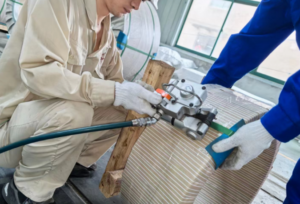Spring steel, a type of steel specifically designed for the fabrication of springs and elastic components, plays a crucial role in determining the reliability and lifespan of these parts. The performance of spring steel is directly influenced by the heat treatment processes it undergoes, emphasizing the importance of optimizing these processes to enhance its overall properties. In this article, let’s take a closer look at the optimization of heat treatment processes for spring steel.

Optimization of Heat Treatment Processes for Spring Steel:
Firstly, quenching is a crucial step in the heat treatment of spring steel. The objective of quenching is to transform the internal microstructure of the steel towards martensite or bainite, thereby enhancing its rigidity, hardness, and wear resistance. To achieve higher strength in spring steel, it is necessary to adjust the cooling rate during quenching and select an appropriate quenching medium. For instance, using water or oil as the quenching medium can effectively elevate the strength and rigidity of the spring steel.
Secondly, normalizing is another important process that involves heating the spring steel to a specific temperature, maintaining it for a period, and then cooling it to room temperature. This process modifies the steel’s microstructure, leading to significant improvements in toughness, elasticity, and fatigue resistance. To optimize the normalizing effect, it is crucial to implement protective measures such as decarburization or oxidation prevention on the steel’s surface. Additionally, strict control over the operating temperature is essential to prevent any degradation in properties due to excessive or insufficient temperatures.
Furthermore, tempering follows quenching and serves to alleviate the stresses generated during quenching, stabilizing the steel’s microstructure and conferring both good toughness and strength. Consequently, the tempering temperature and duration are critical parameters that require precise control to ensure optimal overall performance of the spring steel.
Moreover, nitriding is a process that enhances the hardness and wear resistance of spring steel by infiltrating nitrogen atoms into its surface under high temperature and pressure conditions. This forms a hard nitride layer on the steel’s surface, significantly boosting its properties. However, it is imperative to maintain appropriate temperatures during nitriding to avoid compromising the steel’s quality and appearance.
Lastly, surface treatment, as the final step in the heat treatment process, aims to improve the spring steel’s wear and corrosion resistance. Common methods include pickling, zinc plating, and chrome plating. For instance, pickling involves chemically removing oxide scales and rust from the steel’s surface, facilitating subsequent processing. To achieve optimal pickling results, precise control over temperature, concentration, and duration is essential.
Conclusion
In conclusion, optimizing the heat treatment processes for spring steel significantly enhances its strength, hardness, toughness, and fatigue resistance. Depending on the specific performance requirements and application scenarios, appropriate heat treatment methods can be selected to achieve the desired properties of the spring steel.
Why Choose Sino Special Metal?
Thank you for reading our article and we hope it can help you to have a better understanding of the optimization of heat treatment processes for spring steel. If you are looking for spring steel suppliers and manufacturers online now, we would advise you to visit Sino Special Metal for more information.
As a leading supplier of spring steel from Shanghai China, Sino Special Metal offers customers high-quality spring steel products such as 65Mn Spring Steel, 50CrV4 Spring Steel, 9260 Spring Steel and SUP9 Spring Steel at a very competitive price.




